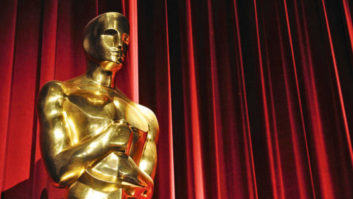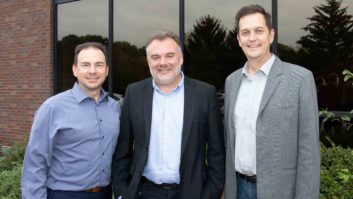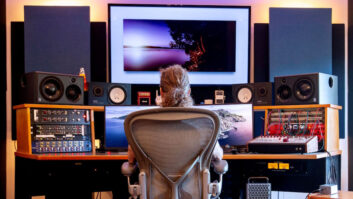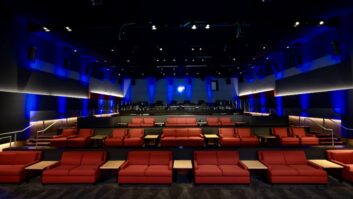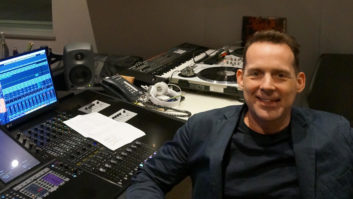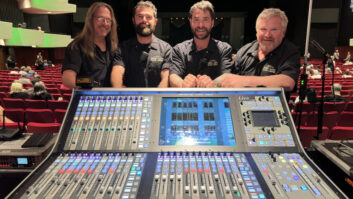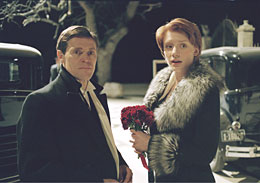
Bryce Dallas Howard raps impatiently on a cabin door. A mule wanders around in a circle, driving a creaky, old water pump. Danny Glover makes his way up a gravel road, the stones crunching beneath his feet. Never mind that there are no sets for the actors to interact with to produce those sounds; audiences watching Lars von Trier’s Manderlay will have long forgotten that minor detail after just a few minutes’ viewing.
The second in von Trier’s minimalist trilogy — which began with the 2003 Dogville, starring Nicole Kidman — the film brings viewers into the world of a 1930s-era Southern plantation, where somebody forgot to tell the owner that slavery had ended 70 years ago. And, like Dogville, the film was shot with the barest of sets — the outlines of buildings and roads painted out on the floor giving the only clue to their existence. The rest is up to the actors, the audience’s imagination — and the sound department.
Von Trier enlisted the expertise of sound designer Kristian Eidnes Andersen, who has previously worked on a number of von Trier’s films, including Dogville, Dancer in the Dark (2000) and others.
“Lars’ usual method is to go for a realistic approach,” says Eidnes from Mainstream, his studio facility in Copenhagen, Denmark, where the film was mixed. “With Breaking the Waves and Dancer in the Dark, we had a ton of atmosphere, direct sound and Foley work. He generally doesn’t like it to be too smooth. Manderlay is quite the opposite.”
The absence of sets makes a realistic soundtrack critical to the audience’s experience. “That’s a big part of the concept: to provide a kind of naturalistic sound,” the director tells Mix. “It’s important to ‘fill in the gaps,’ so to say, with sound.”
Filmed in a former aircraft-assembly building in Sweden, the actors were recorded by production sound mixer Ad Stoop, who used both boom mics and lavaliers, the latter placed in the actors’ hair. “For a lot of the dialog, it really provides a much cleaner track, with no air,” notes Eidnes.
Boom mics were used, says von Trier, to aid in capturing what he calls “100-percent sound,” or naturalistic sound. “It helps us to randomize the sound, because normal recording is not perfect. For recording some voices, we would even place the boom mic slightly off from where it should be.”

Lars von Trier (left) and Kristian Eidnes Andersen mix the
“naturalistic” soundtrack of Manderlay in Mainstream Studio,
Copenhagen, Denmark.
photo: BERIT DYREBORG-CARLSEN
Stoop recorded on the set using a pair of Tascam DA-98s to capture up to 16 mics on discrete tracks, making a live mono mix for immediate use by the film editor.
For sound effects, Eidnes and von Trier spotted from a print of art director Peter Grant’s floor plan of the set. “Just as we did for Dogville, we looked at the drawing and noted, ‘Okay, this area will have grass. This road will be made of gravel; this part with a little less gravel.’ We’d work it out schematically and have a fixed plan so the Foley recorder doesn’t need to be told every little detail; he just works from the map.”
The pair even got as specific as spelling out the seasons represented in each portion of the film in order to plan for seasonal sounds, such as winds, crunching leaves, etc. Eidnes enlisted the help of American effects editor Coll Anderson as a consultant, the two having worked together recently on Thomas Vinterberg’s Dear Wendy. “I wanted to make sure the sounds were accurate for the seasons, as represented in an American environment, such as crickets and things like that.”
Certain sounds required careful planning for Foley recordist Pétur Einarsson and Foley artist Julien Naudin, whose work had to be mixed with care. For that task, Eidnes generated a set of rules to follow. “What are we hearing when we are outside a house looking into it and not hearing the activities on the inside? Or if we’re inside, what from the outside do we hear?” Eidnes explains. “There might be a Foley sound, say, of someone outside a cabin chopping wood. If we’re inside the house, all we should hear is a dull thud.”
Some sound design issues were built into the script, Eidnes says. “We had a well operated by a donkey walking around in a circle, turning this mechanism, for which we needed squeaking sounds.” The donkey was filmed live, though its footsteps were not recorded. “We actually stripped all of the direct sound from the soundstage because the floor material from the original aircraft-assembly building had an asphalt surface, which was too soft to produce the correct sound of the animal’s hooves. So that had to be recorded in post. And then later, the characters slaughter the donkey for food, so we had to record people’s footsteps when they began operating the pump.”
A von Trier trademark — jump-cutting from different takes within single shots — made for an interesting challenge for the sound team. “My technique is to shoot a lot of material, to have the actors perform the scene in variety of ways, and then put the whole thing together from these various takes in the editing room,” the director explains. “So then we mark these edits with a sound. But we have to cheat a little, since most of the sound was constructed artificially afterward.”
“When you have a time cut like that,” says Eidnes, “you have to have a time cut in the sound, as well, with atmosphere, Foley sounds or a microphone scratch.” In one example, a meeting is taking place in one of the cabins on a day when it is raining outside. “You can jump the level of the rain and cut hard on the rain at a higher level, even when the picture is simply cutting from a two-shot to a two-shot.”
The music for the film, notes von Trier, “is a strange choice, a kind of Baroque/Renaissance music. In my mind, I pictured a small orchestra, the size that could fit in a small theater.” According to Eidnes, “Our composer, Joachim Holbek, rewrote these edited classical pieces and recorded them in London with a Baroque orchestra.”
The mix took place at Mainstream, where Eidnes worked with dialog editor Anne Jensen on Pro Tools HD. “We tried to create a very dynamic mix,” Eidnes says. “All of these different small sounds are very important to help keep the audience in the story. They have to be very subtle — you shouldn’t hear every little detail, but only every third footstep, for example.” For music stems, Eidnes isolated soloists, allowing them to be pulled back where needed to avoid conflict with narration changes. “I actually had the whole symphonic session in Pro Tools, but only on two or three stems.” The mix was then mastered to Dolby DMU AC3.
The result is a mix that, temporarily, helps the audience disregard the fact that they are watching a film with no sets, allowing their imaginations to do the rest. “I think you wouldn’t be able to hear all of these sounds on a conscious level,” says von Trier. “We put them in just to give a feeling of reality.”
